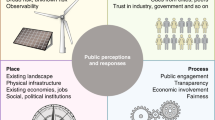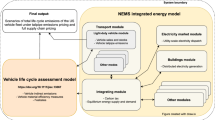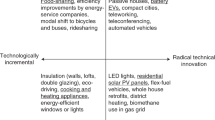Abstract
Identifying feedback loops in consumer behaviours is important to develop policies to accentuate desired behaviour. Here, we use Granger causality to provide empirical evidence for feedback loops among four important components of a low-carbon economy. One loop includes the cost of installing rooftop solar (Cost) and the installation of rooftop solar (photovoltaics, PV); this loop is probably generated by learning by doing and reductions in the levelized cost of electricity. The second includes the purchase of electric vehicles (EV) and the installation of rooftop solar that is probably created by environmental complementarity. Finally, we address whether installing charging stations enhances the purchase of electric vehicles and vice versa; there is no evidence for a causal relation in either direction. Together, these results indicate ways to modify existing policy in ways that could trigger the Cost↔PV↔EV feedback loops and accelerate the transition to carbon-free technologies.
This is a preview of subscription content, access via your institution
Access options
Access Nature and 54 other Nature Portfolio journals
Get Nature+, our best-value online-access subscription
$29.99 / 30 days
cancel any time
Subscribe to this journal
Receive 12 digital issues and online access to articles
$119.00 per year
only $9.92 per issue
Buy this article
- Purchase on Springer Link
- Instant access to full article PDF
Prices may be subject to local taxes which are calculated during checkout


Similar content being viewed by others
Data availability
Monthly observations for the purchase of electric vehicles are obtained from the MOR-EV programme. The location and number of public charging stations are obtained from the Alternative Fuels Data Center Station Locator electric vehicle supply equipment database54. Monthly installations of residential solar photovoltaic, which we term rooftop solar, and the cost of installation are obtained from the Massachusetts Renewable Portfolio Standards Solar Carve-Out II Renewable Generation dataset55. These data and the computer code can be obtained are available on OpenBU, which is FAIR compliant and can be accessed through a globally unique and eternally persistent identifier, https://open.bu.edu/handle/2144/41462. This dataset is distributed under the terms of the Creative Commons Attribution-ShareAlike 4.0 Licence (http://creativecommons.org/licenses/by-sa/4.0).
Code availability
The code is available on OpenBU, which is FAIR compliant, and can be accessed through a globally unique and eternally persistent identifier, https://hdl.handle.net/2144/40340.
References
IPCC: Summary for Policymakers. In Special Report on Global Warming of 1.5 °C (eds Masson-Delmotte, V. et al.) (WMO, 2018).
Samadi, S. The experience curve theory and its application in the field of electricity generation technologies—a literature review. Renew. Sustain. Energy Rev. 82, 2346–2364 (2018).
Levelized Cost and Levelized Avoided Cost of New Generation Resources AEO201925 (US Energy Information Administration, 2019).
Coffman, M., Bernstein, P. & Wee, S. Integrating electric vehicles and residential solar PV. Transp. Policy 53, 30–38 (2017).
Rezvani, Z., Jansson, J. & Bodin, J. Advances in consumer electric vehicle adoption research: a review and research agenda. Transp. Res. D.: Transp. Environ. 34, 122–136 (2015).
Carley, S., Krause, R. M., Lane, B. W. & Graham, J. D. Intent to purchase a plug-in electric vehicle: a survey of early impressions in large US cities. Transp. Res. D.: Transp. Environ. 18, 39–45 (2013).
Graham-Rowe, E. et al. Mainstream consumers driving plug-in battery-electric and plug-in hybrid electric cars: a qualitative analysis of responses and evaluations. Transp. Res. A.: Policy Pr. 46, 140–153 (2012).
Lebeau, K., Van Mierlo, J., Lebeau, P., Mairesse, O. & Macharis, C. The market potential for plugin hybrid and battery electric vehicles in Flanders: a choice-based conjoint analysis. Transp. Res. D.: Transp. Environ. 17, 592–597 (2012).
Gallagher, K. S. & Muehlegger, E. Giving green to get green? Incentives and consumer adoption of hybrid vehicle technology. J. Environ. Econ. Manag. 61, 1–15 (2011).
Krupa, J. S. et al. Analysis of a consumer survey on plug-in hybrid electric vehicles. Transp. Res. A.: Policy Pr. 64, 14–31 (2014).
Sierzchula, W., Bakker, S., Maat, K. & Wee, B. The influence of financial incentives and other socio-economic factors on electric vehicle adoption. Energy Policy 68, 183–194 (2014).
Zhang, Y., Yu, Y. & Zou, B. Analyzing public awareness and acceptance of alternative fuel vehicles in China: the case of EV. Energy Policy 39, 7015–7024 (2011).
DeShazo, J. R. Improving incentives for clean vehicle purchases in the United States: challenges and opportunities. Rev. Environ. Econ. Policy 10, 149–165 (2016).
Chandra, A., Gulati, S. & Kandlikar, M. Green drivers or free riders? An analysis of tax rebates for hybrid vehicles. J. Environ. Econ. Manag. 60, 78–93 (2010).
Arraujo, K., Boucher, J. L. & Aphale, D. A clean energy assessment of early adopters I electric vehicles and solar photovoltaic technology: geospatial, political, and socio-demographic trends in New York. J. Clean. Prod. 216, 99–116 (2019).
Zhang, Q. et al. Factors influencing the economics of public charging infrastructure for EV—a review. Renew. Sustain. Energy Rev. 94, 500–509 (2018).
Neaimeh, M. et al. Analysing the usage and evidencing the importance of fast chargers for the adoption of battery electric vehicles. Energy Policy 108, 474–486 (2017).
Axsen, J., TyreeHageman, J. & Lentz, A. Lifestyle practices and pro-environmental technology. Ecol. Econ. 82, 64–74 (2012).
Franke, T. & Krems, J. F. Interacting with limited mobility resources: psychological range levels in electric vehicle use. Transp. Res. A.: Policy Pr. 48, 109–122 (2013).
Way, R., Lafond, F., Lillo, F., Panchenko, V. & Farmer, J. D. Wright meets Markowitz: how standard portfolio theory changes when assets are technologies following experience curves. J. Economic Dyn. Control 101, 211–238 (2019).
Kim, K., Heo, E. & Kim, Y. Dynamic policy impacts on a technical-change system of renewable energy: an empirical analysis. Environ. Resour. Econ. 66, 205–236 (2017).
Farmer, J. D. et al. Sensitive intervention points in the post-carbon transition. Science 364, 132–134 (2019).
Kaufmann, R. K. & Stern, D. I. Evidence for human influence on climate from hemispheric temperature relations. Nature 38, 39–44 (1997).
Gillingham, K., Newell, R. G. & Pizer, W. A. Modeling endogenous technological change for climate policy analysis. Energy Econ. 30, 2734–2753 (2008).
Arrow, K. The economic implications of learning by doing. Rev. Econ. Stud. 29, 155–173 (1962).
Elshurafa, A. M., Albardi, S. R., Bigerna, S. & Bollino, C. A. Estimating the learning curve of solar PV balance-of-system for over 20 countries: implications and policy recommendations. J. Clean. Prod. 196, 122–134 (2018).
Garzón Sampedro, M. R. & Sanchez Gonzalez, C. Spanish photovoltaic learning curve. Int J. Low.-Carbon Technol. 11, 177–183 (2016).
Shum, K. L. & Watanabe, C. Towards a local learning (innovation) model of solar photovoltaic deployment. Energy Policy 36, 508–521 (2008).
Wiser, R. et al. Analyzing historical cost trends in California’s market for customer-sited photovoltaic. Prog. Photovolt.: Res. Appl. 15, 69–85 (2007).
Fu, R. Feldman, D. & Margolis, R. U.S. Solar Photovoltaic System Cost Benchmark: Q1 2018 NREL/TP-6A20-72399 (NREL, 2018); https://www.nrel.gov/docs/fy19osti/72399.pdf
McGrath, M. Product Strategy for High Technology Companies 2nd edn (McGraw-Hill, 2001).
Neij, K., Heiskanen, E. & Strupeit, L. The deployment of new energy technologies and the need for local learning. Energy Policy 101, 274–263 (2017).
Robinson, J., Brase, G., Griswald, W., Jackson, C. & Erikson, L. Business models for solar powered charging stations to develop infrastructure for electric vehicles. Sustainability 6, 7358–7387 (2014).
Costs Associated with Non-Residential Electric Vehicle Supply Equipment, Factors to Consider in the Implementation of Electric Vehicle Charging Stations (US Department of Energy, 2015).
Hoarau, Q. & Perez, Y. Interactions between electric mobility and photovoltaic generation: a review. Renew. Sustain. Energy Rev. 94, 510–522 (2018).
Lemenager, T., King, D., Elliot, J., Gibbon, H. & King, A. Greater than the sum of their parts: exploring the environmental complexity of state, private, and community protected areas. Glob. Ecol. Conserv. 2, 238–247 (2014).
Nienhueser, I. A. & Qui, Y. Economic and environmental impacts of providing renewable energy for electric vehicle charging—a choice experiment study. Appl. Energy 180, 256–268 (2016).
Eppstein, M. J., Grover, D. K., Marshall, J. S. & Rizzo, D. M. An agent-based model to study market penetration of plug-in hybrid electric vehicles. Energy Policy 39, 3789–3802 (2011).
Wolske, K. S., Gillingham, K. T. & Schultz, P. W. Peer influence on household energy behaviors. Nat. Energy 5, 202–212 (2020).
Barth, M., Jugert, P. & Fritsche, I. Still underdetected—social norms and collective efficacy predict the acceptance of electric vehicles in Germany. Transp. Res. F. 37, 64–77 (2016).
Cialdini, R. and Trost, M. R. in The Handbook of Social Psychology (eds Gilbert, D. T. et al.) (Oxford Univ. Press, 1998).
van Zomeren, M., Postmes, T. & Spears, R. Toward an integrative social identity model of collective action: a quantitative research synthesis of three socio-psychological perspectives. Psychological Bull. 134, 504–535 (2008).
Bollinger, B. & Gillingham, K. Peer effects in the diffusion of solar photovoltaic panels. Mark. Sci. 31, 900–912 (2012).
Mau, P., Eyzaguirre, J., Jaccard, M., Collins-Dodd, C. & Tiedemann, K. The ‘neighbor effect’: simulating dynamics in consumer preferences for new vehicle technologies. Ecol. Econ. 68, 504–516 (2008).
Zhu, X. & Liu, C. Investigating the neighborhood effect on hybrid vehicle adoption. Transp. Res. Rec. 2385, 37–44 (2013).
Jansson, J., Pettersson, T., Mannberg, A., Brannlund, R. & Lindgren, U. Adoption of alternative fuel vehicles: influence from neighbors, family, and coworkers. Transp. Res. D.: Transp. Environ. 54, 61–75 (2017).
Rai, V. & Robinson, S. A. Effective information channels for reducing costs of environmentally-friendly technologies: evidence from residential PV markets. Environ. Res. Lett. 8, 014044 (2013).
Li, S., Tong, L., Xing, J. & Zhou, Y. The market for electric vehicles: indirect network effects and policy design. J. Assoc. Environ. Resour. Econ. 4, 89–133 (2017).
Morrissey, P., Weldon, P. & O’Mahony, M. Future standard and fast charging infrastructure planning: an analysis of electric vehicle charging behaviour. Energy Policy 89, 257–270 (2016).
Bose, J. et al. NHTS 2001 Highlights Report. Bureau of Transportation Statistics Report BTS03-05 (US Department of Transportation, 2003).
Gurskiy, D. Apartment EV charging & ownership may be easier than you think. Clean Technica https://cleantechnica.com/2019/09/10/apartment-ev-charging-ownership-may-be-easier-than-you-think/ (2019).
Office of Energy Efficiency & Renewable Energy. Pump up the charge with extreme fast charging. Office of Energy Efficiency & Renewable Energy https://www.energy.gov/eere/articles/pump-charge-extreme-fast-charging (2017).
Zhou, Y. & Li, S. Technology adoption and critical mass: the case of the US electric vehicle market. J. Ind. Econ. 66, 423–480 (2018).
Federal EV tax credit phase out tracker by automaker. EV Adoption https://evadoption.com/ev-sales/federal-ev-tax-credit-phase-out-tracker-by-automaker/ (2020).
Wiser, R. Bollinger, M. Cappers, P. & Margolis, R. An Empirical Investigation of Photovoltaic Cost Trends in California LBNL-59282 (Lawrence Berkeley National Laboratory, 2006).
SREC. Solar Renewable Energy Certificates https://www.srectrade.com/markets/rps/srec/ (2020).
Massachusetts offers rebates for electric vehicles, rebate statistics. Center for Sustainable Energy, Massachusetts Department of Energy Resources http://mor-ev.org/program-statistics (2020).
. Electric vehicle charging locations US Department of Energy https://afdc.energy.gov/fuels/electricity_locations.html#/find/nearest?fuel=ELEC (2020).
List of qualified generating units. Commonwealth of Massachusetts http://www.mass.gov/eea/energy-utilities-clean-tech/renewable-energy/rps-aps/qualified-generation-units.html(2020).
Hadri, K. Testing for stationarity in heterogeneous panel data. Econ. J. 3, 148–161 (2000).
Breitung, J. in Advances in Econometrics Vol. 15 (ed. Baltagi, B. H.) 161–178 (JAY Press, 2000).
Im, K. S., Pesaran, M. H. & Shin, Y. Testing for unit roots in heterogeneous panels. J. Econ. 115, 53–74 (2003).
Levin, A., Lin, C. F. & Chu, C. S. J. Unit root tests in panel data: asymptotic and finite-sample properties. J. Econ. 108, 1–24 (2002).
Dumitrescu, E. & Hurlin, C. Testing for Granger non-causality in heterogeneous panels. Econ. Model. 29, 1450–1460 (2012).
Akaike H. Information theory and an extension of the maximum likelihood principle. In Proc. 2nd International Symposium on Information Theory (eds Petrov, P. N. & Csaki, F.) 267–281 (Akademiai Kiado, 1973).
Holtz-Eakin, D., Newey, W. & Rosen, H. S. Estimating vector autoregressions with panel data. Econometrica 56, 1371–1396 (1988).
Acknowledgements
We thank the members of Project Link for comments on a preliminary version of this manuscript. We also thank F. Khan, K. Florini, Q. Hoarau, J. Jannsson and G. Wagner for comments on preliminary versions of this manuscript. Any mistakes that remain are solely our responsibility.
Author information
Authors and Affiliations
Contributions
This project was conceived by R.K.K. and D.N. and modified by C.X. and S.G. D.N. compiled the data used in the original analysis. C.X. updated the data that were used in the analysis reported in the main text. R.K.K. took the lead in estimating the statistical models in Rats. D.N. wrote the first version of the manuscript, which was modified by R.K.K. with significant input from D.N., C.X. and S.G. R.K.K. took the lead in designing the figures and Fig. 2 was generated by C.X.
Corresponding author
Ethics declarations
Competing interests
The authors declare no competing interests.
Additional information
Peer review information Nature Energy thanks Chien-fei Chen, Gregory Nemet and the other, anonymous, reviewer(s) for their contribution to the peer review of this work.
Publisher’s note Springer Nature remains neutral with regard to jurisdictional claims in published maps and institutional affiliations.
Supplementary information
Supplementary Information
Supplementary Information and Tables 1–6.
Rights and permissions
About this article
Cite this article
Kaufmann, R.K., Newberry, D., Xin, C. et al. Feedbacks among electric vehicle adoption, charging, and the cost and installation of rooftop solar photovoltaics. Nat Energy 6, 143–149 (2021). https://doi.org/10.1038/s41560-020-00746-w
Received:
Accepted:
Published:
Issue Date:
DOI: https://doi.org/10.1038/s41560-020-00746-w
This article is cited by
-
Sustainable plug-in electric vehicle integration into power systems
Nature Reviews Electrical Engineering (2024)
-
Spatial and relational peer effects on environmental behavioral imitation
Environmental Economics and Policy Studies (2023)
-
Resilience of urban public electric vehicle charging infrastructure to flooding
Nature Communications (2022)



